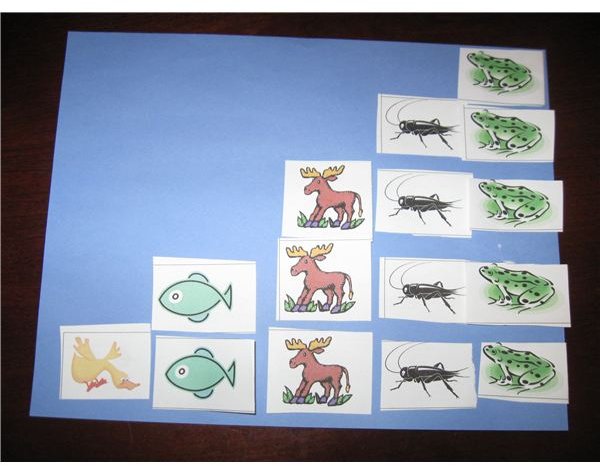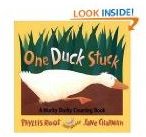"One Duck Stuck": Growing Pattern Lesson Plan for Kindergarten
What Comes Next?
A growing pattern is one that increases or decreases by a constant difference. The way we count is an example, because the numbers increase by one. In this lesson, kindergarten children will begin to recognize that each number is one more than the one before it. While this concept seems simple, it is an important building block that will later help children to write larger numbers and to add and subtract by one effortlessly.
Materials
One Duck Stuck, by Phyllis Root
Pocket Chart or chart paper
55 small squares of paper or sticky notes
Snap cubes
Animal Images from <em>One Duck Stuck</em>
Construction Paper
Scissors and glue
Procedure
Show the class the book One Duck Stuck. Read the title and author, look at the cover illustrations and let a few children make predictions before you begin reading the story. As you read, talk about the animals who are trying to help and find and count them on each page. After the four crickets come to help, stop reading and ask the children what animal they think will come next. Then ask how many they think will come. Read the next page, five frogs, and then talk about their predictions. Hopefully, they predicted that five animals would be next. Ask how they knew. Continue to read, stopping one or two more times to let the children predict and then discuss their predictions.
Next, give each child or pair of children 55 snap cubes of the same color. Tell them that you are going to read the story again and they are going to make cube trains for each animal in the story. Start reading and put one square or sticky note in the bottom row of your pocket chart and have the children take one snap cube for the duck. Next place two squares next to the first one on the last and next-to-last row of the pocket chart. Have the children make a stack of two cubes and place it next to the single cube. Continue reading and making the stacks until all ten are made. Lined up smallest to largest, the cube trains should look like a triangle.
Ask the children to look at both their cubes and the chart that you have made. What do they notice? They may say that it is a triangle or stairs or notice that it increases by one each time. Ask them, what would happen if, instead of all the animals working together, a new animal, like raccoons, came to help. How many would come? Explain that they are able to predict because the story follows a pattern. It isn’t a repeating pattern like they have worked with before, but a growing pattern, because the numbers get bigger each time, but always by one. If thirteen animals came next instead of eleven, it would not follow the pattern, because that would be three more, instead of one.
Give each child a piece of construction paper, a copy of the animal pictures from the book, scissors and glue. Each child should cut the animal pictures apart and then glue them to the construction paper to recreate the growing pattern.
Assessment

Because this is an introductory lesson, an informal assessment will help you see which students understand the concepts and which ones are still struggling. Listen to their responses as they discuss the snap cube models they made. Look at the patterns they made with the pictures. Were they able to line up the animals in the right order? Did they make the growing pattern or did any children try to make a repeating pattern with the pictures? If time allows, individually ask the students to tell you about their papers.
Extension
Continue to read counting books and point out the patterns. Ten Black Dots, by Donald Crews and Rooster’s Off to See the World, by Eric Carle are two really good choices to help children visualize the concept.
Try to work examples into other areas of the curriculum. In science, you might pose a problem about a flower that grows 1 inch every day. If it is 1 inch tall on the first day and 2 inches tall on the second, how tall will it be on day 3? Day 5? Day 10?
Continue to teach both repeating and growing patterns in the kindergarten math curriculum to help your students build a strong foundation for patterns and relationships.
Resources and Photo Credits
Dacey, Linda and Eston, Rebecca. Show and Tell: Representing and Communicating Mathematical Ideas in K-2 Classrooms. Math Solutions Publications, 2002.
Root, Phyllis and Chapman, Jane. One Duck Stuck. Candlewick, 2003.
Photo Credits
Book cover image provided by Amazon.com
Other images provided by author
